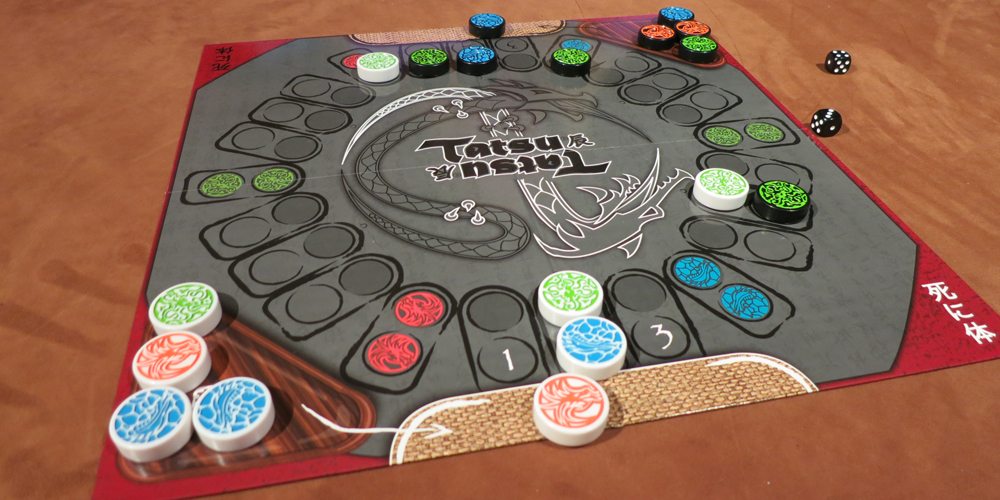
At a Glance
The legend goes that once upon a time there was a battle between two mighty dragon armies. The battle was so ferocious that people of the local village employed the services of a wizard to imprison the dragons, only to be released when combat is done. Today, the battle wages still… on your kitchen table.
Tatsu: A Game of Dragon Mastery is a two-player game for ages 8 and up, which plays in about 30 minutes.
Components
There’s not a lot here, just a playing board, a pair of dice, and 18 Dragon stones (three types in two colors). The Dragon stones are made from the same satisfyingly heavy Bakelite material that Tatsu‘s designer, John Yianni, used on one of his other games, Hive.
The board is of good quality and the illustrations on it are good and helpful. The Dragon stones are fantastic. If you’re familiar with Hive‘s pieces, you will know what I’m talking about it. They are tough, durable and have a heft that makes you feel like you are ready for the challenge of facing off against an adversary. The dice… well, they’re dice.

The Dragon stones come in both white and black, one set for each player. Within those divisions, there are four green stones to represent the Vine Dragon, three blue stones for the Water Dragon, and two orange stones for the Fire Dragon. More about their abilities in a moment, but that’s about it for the components.
Since I’m supposed to talk about the components and there’s not much more to say, I’ll mention the box. As you can see from the top photo, the box has a huge hole in the middle of it. Additionally, it opens from the top end, tuck-box style, so all of these pieces have to be gently slid in and out of the box, being careful not to rip the plastic insert, plastic lid, or cardboard if you want to maintain the integrity of the box for storage. I’ll likely replace it in the future because it’s a crummy solution for longtime use. I like holding on to original packaging for a number of reasons: I can quickly identify games on my shelf, they protect my games, and I don’t feel like it should be my responsibility to come up with another solution for storage when almost every other game box can be reused for storage. So I’m not crazy about this. I am, however, a big fan of the game. It’s pretty great. Let me tell you why…

How to Play
Players sit opposite each other, positioning the board so that one of the mat images is in front of them. There’s a black side and a white side, so players take the corresponding Dragon stones or spin the board, if they are allegiant to one set or the other. Three of the green Vine stones are placed above the three start points in front of each player. The remaining stones go on the printed tray to their left sides.
Play in Tatsu is similar in many ways to backgammon. On each person’s turn, they roll the dice. Black moves clockwise, white counterclockwise. If you forget, the giant Dragons in the center of the board remind you, just follow the direction of their heads. Each position around the board has two rings, an inner and an outer. The inner ring is always used unless a stone is already in that position, in which case the outside position is used. A stone may pass through an occupied position (counting the movement) but may never end its movement on a position that already has two stones.
There are six “corners” on this circle (their terminology, not mine), two for each color, orange, blue, and green. If you land on any of these, it allows you to recruit a corresponding Dragon stone from your tray. Recruited stones move to your mat. On subsequent turns, a roll of 1, 2, or 3 will allow the player to place a recruited stone on the board at the corresponding position.

Like backgammon, a player may choose to move two stones or one, but the value of a die may not be split. You must move the full value shown on each face and when moving only one stone, you must be able to make a legal move for each of the die faces (rather than just the total value). If you stop at a position that already holds one of your own stones, the outer stone holds the inner stone, which is considered trapped and may not be moved until the outer stone moves.
However, if your stone ends up on the outer ring of a position where your opponent already is, one of three things happens. The green Vine Dragon stones hold the opposing stone in place until it is released by you or it escapes. Stones that are held by an opponent can escape by rolling the dice on your turn and using the lower rolled die to move your stone. The higher rolled die is sacrificed that turn. This only works when an opponent is holding you and when escaping, the stone that was holding the player moves to the inner ring.
The blue Water Dragon, when landing behind an opponent, washes the opponent away. The opponent’s piece is placed back in their tray and the Water dragon then occupies the inner spot. The orange Fire Dragon destroys its opponent, the piece is removed from the game, placed in the player’s Dead Zone.
The only other rule is that if you can make a legal move with the dice, you must. Sometimes, this might put a player in an undesirable position. Tough luck, though, you have to do it.
Play continues until one of two conditions is met. If you ever finish your turn and your opponent has no stones in the battle (those in the Dead Zone or in the tray do not count), you win. Alternately, If you can destroy all of one kind (Vine, Water, or Fire) of your opponent’s Dragons, you win.

Why You Should Play Tatsu
I have long been a fan of John Yianni’s Hive. For me, it hits the sweet spot for abstract strategy, playing a lot like chess but with different layers of complexity. It’s incredibly portable and, because it’s only Bakelite tiles, I can take it with me camping and other places where a lot of other games can’t go. So, when I saw Hive at a booth at Gen Con, I had to stop.
With my professed love for Hive, you can imagine how excited I got when the guys at Smart Zone Games told me they had a new game coming out from John Yianni. And even more still when they asked me if I wanted to demo it. The game is very quick to pick up and, because I also like backgammon, it instantly consumed me. I ended up playing a whole game at the Smart Zone booth and, after I got up, the game stuck with me. Tatsu is a game that is familiar enough you’ll catch on quickly, but it’s different enough that you’ll think about its strategies and play for a while after.
There is a significant amount of luck because of the dice and, as a result, the strategy ends up being lower than Hive. Still, the balance shifts the game so it’s more equitable between kids and adults. Strategy ends up making decisions about double parking stones to protect them, keeping stones in reserve to guard against a loss, and deciding on distribution of movement.
Tatsu is very enjoyable. As mentioned, the components are great, the box is horrible, but it’s something I get out often. I really enjoy two-player games and Tatsu is a winner for me. I do wish the board had been printed on cloth so I could bring Tatsu with me the same places I bring Hive. It would also solve my gripes about the box.
Disclosure: GeekDad received a sample of this game for review purposes.


